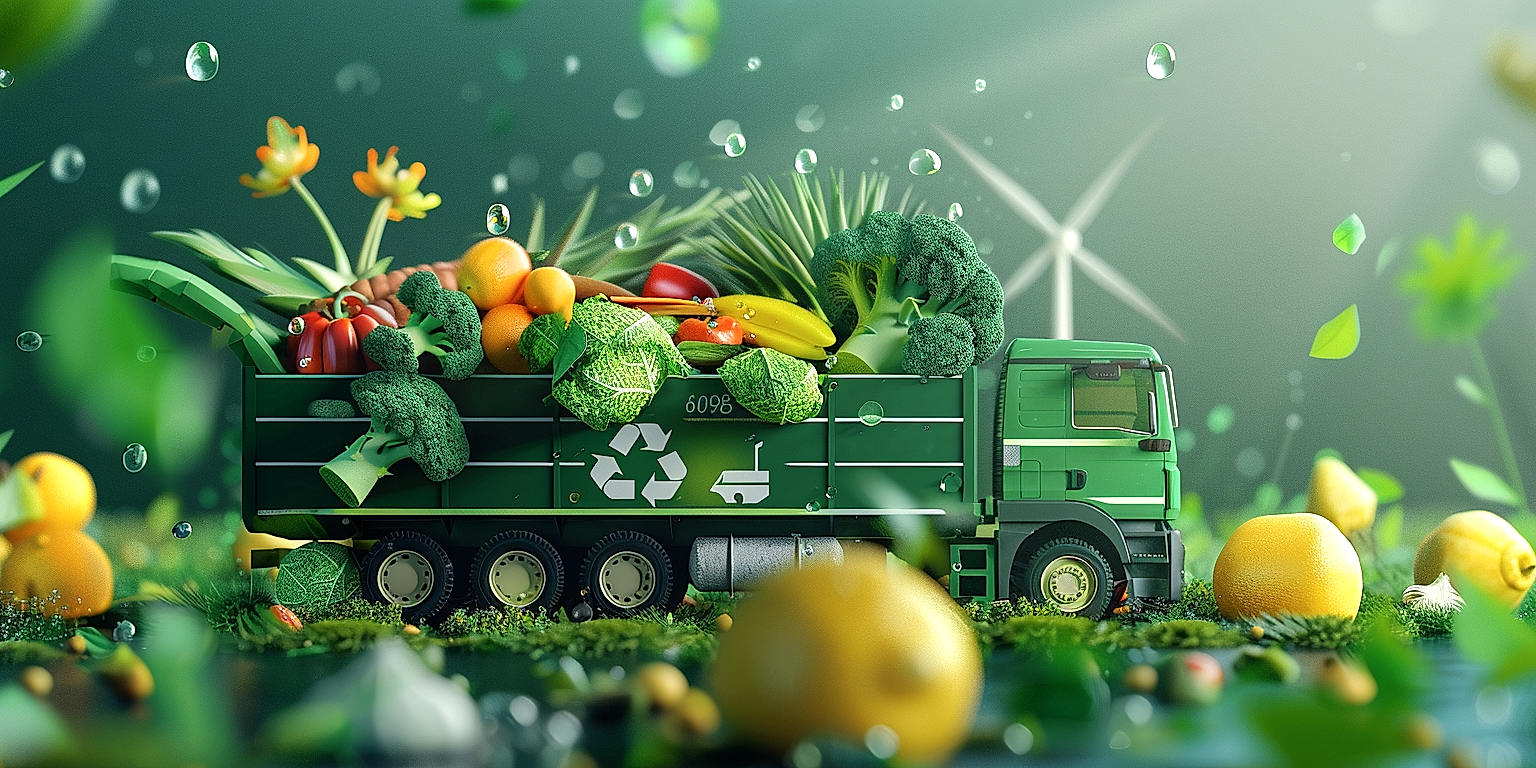Efficient warehouse energy management is a cornerstone for successful produce distribution, coupling cost-effectiveness with environmental responsibility.
With warehouses being potential energy hogs, it becomes crucial to implement energy-saving measures.
The goal is to reduce operational costs without compromising quality and workplace safety.
Yet, figuring the best ways to accomplish this can be challenging.
Whether it’s optimizing lighting, regulating temperature, or streamlining equipment usage, the opportunities to boost energy efficiency are numerous.
Here, we delve into proven tactics that foster sustainability whilst bolstering the bottom-line.
Contents
- Warehouse Energy Savings Tips For Produce Distribution
- 1. Install Energy-Efficient LED Lighting
- 2. Utilize Motion Sensor Lighting in Storage Areas
- 3. Maintain Optimum Cooling Temperatures for Produce
- 4. Regularly Service Cooling Equipment
- 5. Seal loading-dock doors tightly to prevent leakage.
- 6. Use energy management systems to monitor usage.
- 7. Implement solar panels to reduce electrical use.
- The Bottom Line
Warehouse Energy Savings Tips For Produce Distribution
1. Install Energy-Efficient LED Lighting
When looking at any warehouse, especially those involved in produce distribution, lighting plays a significant role in energy use.
Traditional fluorescent or incandescent bulbs consume a substantial amount of power, leading to increased energy expenses.
As part of your warehouse energy-saving strategies, it’s advisable to replace these traditional bulbs with energy-efficient Light Emitting Diode (LED) lights.
LED lights are a fantastic option as they offer considerable energy savings potential.
One of the greatest benefits of using LED lights is that they use 75% less energy than traditional options.
LED lights also last up to 10 times longer which in turn, reduces replacement costs.
Besides the energy savings, LED lights offer better lighting quality, which can improve warehouse safety and worker productivity.
LED lighting also emits less heat, hence less cooling power is required, leading to further energy and cost savings.
Additionally, the light dispersion pattern of LEDs make them ideal for lighting large areas like warehouses.
LED lights distribute light evenly across the desired area thus reducing the number of fixtures needed, and consequently, the overall energy usage.
It’s important to note that the initial cost of purchasing LEDs may be higher, however, their long lifespan and energy efficiency offset this initial cost.
Moreover, many electric companies offer rebates and incentives for businesses switching to energy-efficient lighting.
Such incentives significantly reduce the cost of transitioning to LED lights thus making it a very viable option for produce warehouses.
The installation of LED lights is a process that demands careful planning.
Your warehouse might necessitate different lighting levels in different areas which means that a well thought-out lighting plan is crucial.
Opt for professional installation to ensure that the lighting is set up effectively for maximum energy savings.
2. Utilize Motion Sensor Lighting in Storage Areas
One crucial step in achieving optimal energy savings in a warehouse setup, particularly in a produce distribution context, is the implementation of motion sensor lighting in the storage areas.
Such lighting systems are designed to illuminate spaces only when they detect motion, thus minimizing unnecessary energy consumption.
It is not uncommon to see unoccupied spaces left illuminated in a warehouse environment, which contributes significantly to high energy costs.
Focusing on making strategic changes such as the integration of motion sensor lighting can dramatically reduce these unnecessary costs.
When we talk about motion sensor lighting, we are referring to a system where the lights are intrinsically linked to detectors that are programmed to sense activities or movement in a given area.
When the sensors detect motion, the lights turn on, providing sufficient lighting for the area and shutting off again when the motion ceases.
With this arrangement, there is no need for manual control of the lighting because the sensor does the work, thus lowering energy consumption.
Outfitting a storage area with sufficient motion sensor lights can seem like a cumbersome upfront investment, but the long-term gains in energy savings and efficiency can rapidly offset these initial costs.
Furthermore, in addition to the energy-saving aspect, motion sensor lights also bolster safety and security in the warehouse.
Motion sensor light systems can provide necessary illumination in lower-traffic areas, discouraging potential illicit activities or hazards that could potentially harm employees or damage goods.
The beauty of motion sensor lighting lies in its versatility – these systems can be tailored to fit an array of environments and lighting needs, making it a worthwhile investment for any warehouse setup.
Produce storage areas, for instance, often necessitate specific lighting conditions relating to both intensity and duration.
Motion sensor lighting systems can be adjusted and calibrated to meet these specific needs, ensuring both the quality of the stored produce and ongoing warehouse operations are not compromised.
As you endeavor to optimize your warehouse for energy efficiency, it’s worth considering the switch to motion sensor lighting in your storage areas.
This shift will not only drive down your energy costs but also foster a safer, more efficient working environment for your staff — and that, in the end, can translate to better productivity and bottom-line results in your produce distribution operations.
3. Maintain Optimum Cooling Temperatures for Produce
The investment in maintaining optimum cooling temperatures in your warehouse can significantly reduce energy consumption.
For fresh produce, temperature is a critical component of preserving its freshness and extending its shelf life.
The fluctuation in temperature can lead to increased energy use and waste.
Unregulated temperature results in not only wasted energy but also spoilage of produce, becoming a costly issue.
It is therefore vital to have a reliable cooling system in place that can maintain the right temperature conditions.
When storing produce, every type of fresh product has its specific temperature range at which it should be stored.
Consider the unique cooling needs of different types of produce, ensuring each is stored at its optimum temperature.
With ongoing temperature monitoring, energy use can be optimized by preventing unnecessary cooling.
A key strategy for maintaining optimum cooling temperatures lies in understanding the specific temperature needs of each type of produce and monitoring temperatures regularly.
Advanced cooling systems are equipped with temperature control tools that provide real-time temperature updates and allow for adjustments as needed.
Implementing such technology not only leads to energy savings but also preserves the quality of produce.
Ensure the proper insulation of the warehouse to prevent the escape of cool air and the entry of warmer air.
Use energy-efficient equipment like cooling systems with Energy Star ratings for better temperature management and energy savings.
In the long run, maintaining optimum cooling temperatures through efficient systems and practices will lead to significant energy savings.
This not only enhances the bottom line but also contributes to the environment, making your warehouse operation sustainable and environmentally-friendly.
Finally, staff training on the importance of temperature management and how to operate cooling systems efficiently will further support energy efficiency measures.
4. Regularly Service Cooling Equipment
Maintaining optimal cooling temperatures for produce in a warehouse requires a fully functional cooling system.
The lack of a properly maintained cooling unit can lead to energy wastage and even reduce the quality of the produce stored.
If a cooling system is not regularly serviced, its functioning could become inefficient, leading to excessive energy use.
Therefore, it is imperative for warehouse managers to allocate resources and plan for regular servicing and maintenance of their cooling equipment.
Indeed, one of the most effective Warehouse Energy Savings Tips for Produce Distribution is to carry out frequently scheduled maintenance on all cooling units.
Professionally conducted preemptive maintenance can significantly minimize any future costly repairs or replacements, as well as help to improve energy efficiency.
Some essential steps that should be part of this regular service include cleaning the cooling units, checking for leakages, and confirming optimal refrigerant levels.
While cleaning and maintenance can be executed by the warehouse staff, certain procedures, such as checking refrigerant levels and leaks, require a certified technician.
The condenser coils should be cleaned regularly in order to remove dirt and grime, as these can reduce the efficiency of the cooling unit.
In addition, servicing the cooling equipment also involves checking and possibly replacing air filters, rusted or worn-out parts, as well as performing an overall system check to ensure it is running optimally.
Just like other mechanical systems, parts of the cooling equipment experience wear and tear over time and may need replacement.
Failing to replace such parts in time can lead to inefficient operation and thus increase energy consumption.
An energy efficient warehouse is one that actively resorts to regular servicing of cooling equipment to ensure longevity, effectiveness and efficiency.
It should also be noted that the frequency of service will depend on the type of unit and how heavily it is used, thus careful monitoring of the strengths and weaknesses of the system is recommended.
A well serviced cooling system not only ensures longevity of the equipment, but also guarantees that produce stays in an optimal chilled environment, which longitudinally saves on costs related to waste or spoilage.
5. Seal loading-dock doors tightly to prevent leakage.
One of the most overlooked ways of saving energy in a produce distribution warehouse is the proper sealing of loading-dock doors.
Energy tends to escape from these doors whenever they are not completely closed, leading to increased energy consumption to keep the warehouse at the right temperature.
By ensuring the doors are sealed tightly, a warehouse can notably reduce energy leakage thus leading to energy savings.
A tightly sealed loading door can retain more energy within the warehouse, culminating in lower energy bills over time.
The first step towards achieving this is by making sure that gaskets, weather-stripping, and other sealing materials are properly installed around the doors.
These materials serve to create a barrier that prevents both the external air and temperature from entering the warehouse and the internal air from escaping.
Since produce distribution warehouses often need to maintain a specific climate, this reduces energy expenditure on air conditioning or heating to maintain the necessary conditions.
Regular inspections should be conducted to check for any damages that might lead to air leakage, as even a small gap can lead to significant energy loss over time.
When damages are found, they should be repaired immediately to prevent further energy leakage.
Investing in high-quality doors can also be beneficial, as they often provide better insulation and can withstand the frequent usage typical in a warehouse setting.
However, investing in expensive doors is not enough.
Maintenance plays an equally crucial role: doors should be regularly serviced and parts that show signs of wear and tear should be replaced. A poorly maintained door will not work efficiently, regardless of its quality.
In addition, the door closing practices can have a significant impact on a warehouse’s energy efficiency. All doors should be kept closed when not in use. A policy or protocol for keeping doors closed when not in use can contribute to maintaining the temperature within the warehouse.
Lastly, the implementation of energy management systems can provide valuable data to monitor door usage and identify areas for improvement to save energy. These systems often provide insights that can drive further energy-saving initiatives in the warehouse.
Overall, ensuring a tight seal on loading-dock doors is a relatively simple yet efficient way to achieve substantial energy savings in a produce distribution warehouse.
6. Use energy management systems to monitor usage.
Most warehouses work around the clock, consuming a significant amount of energy, and it’s essential to ensure that energy usage remains efficient.
One practical strategy to achieve this is through the implementation of energy management systems.
These systems provide an advanced platform for monitoring energy usage in real-time, allowing tracking, controlling, and optimizing the wastage.
Modern energy management systems can analyze and display the energy consumption patterns of different machinery and equipment inside a warehouse.
Thus, the users can identify high power consumption equipment and take necessary actions to mitigate their energy usage.
Most systems can also visualize the loads on different electrical lines, making it easier to balance the load and use energy more wisely.
They can also highlight any anomalies or deviations in energy usage, which might suggest a problem with the equipment or power infrastructure.
An integral part of these systems is automated reporting, which not only saves time but also provides a wealth of data for better decisions making regarding energy management.
An energy management system can generate alerts in case the energy consumption goes beyond a preset threshold as well – this feature provides a layer of protection against excessive energy usage.
Implementing such systems in warehouses dedicated to produce distribution is even more critical, as maintaining the optimal cooling temperature for the produce is a significant energy consuming operation.
Using an energy management system, warehouse managers can optimally control the cooling equipment and prevent energy wastage.
Not to mention, applying energy management measures might also qualify warehouses for energy-saving rebate programs offered by many government and non-government institutions.
Moreover, demonstrating commitment towards energy-management can enhance a company’s reputation, by projecting them as a responsible and sustainability-focused organization.
In essence, an energy management system can serve as a powerful tool to reduce energy wastage, enhance cost-saving, and promote sustainability in warehouse operations.
Therefore, it becomes an essential component of warehouse energy saving strategies, particularly for produce distribution centers that rely heavily on maintaining the right balance of temperature and energy consumption.
7. Implement solar panels to reduce electrical use.
The introduction of solar panels into the day-to-day operations of a warehouse can significantly impact the energy usage for produce distribution centers.
Switching to solar energy not only contributes to the environment but also decreases the operational costs of the warehouse.
The initial investment in solar panels may seem significant but the long-term savings on energy bills justify the cost.
Moreover, the decreasing cost of solar panels makes this upgrade even more financially viable for businesses.
Grants, subsidies and governmental incentives to implement clean energy can further lower the cost of installing solar panels.
Reduced dependence on the grid can insulate your business from unexpected energy price hikes and disruptions in service.
By harnessing the power of the sun, warehouses can effectively manage and reduce their electrical use, while also contributing to environmental sustainability.
Choosing a solar panel system that is most suitable to your warehouse demands and energy needs is crucial for effective energy saving.
It’s also important to ensure that the installation location of the solar panels can receive ample sunlight throughout the day.
A professional solar installation company with expertise in the technical aspects can ensure the most efficient use of the installed solar panels.
Conducting regular maintenance checks on the solar panels can ensure they’re performing at their optimal level and maximum efficiency.
Consider a solar storage battery to store excess solar energy produced during the day for use when the sun isn’t shining, making for an even more energy-efficient solution.
Integrating a solar system into your existing energy management systems can allow you to monitor and better control your energy usage.
Also, installing solar panels could contribute to improving your brand’s eco-friendly image, which could attract more clients.
In a nutshell, solar panels can significantly reduce electrical use and help to achieve the goal of running an energy-efficient warehouse.
The Bottom Line
Implementing these best practices not only contributes to a greener environment, but also significantly reduces overall operational costs in the foodservice industry.
By adopting energy-efficient methods like installing LED lighting, using motion sensor lighting, managing cooling temperatures, regularly servicing cooling equipment, and tightly sealing loading-dock doors, establishments can vastly reduce energy waste.
The added utilization of energy management systems and solar panels can further enhance these efforts and lower electrical use.
Ultimately, these steps will lead to an operation that is more responsible, economical, and sustainable.




